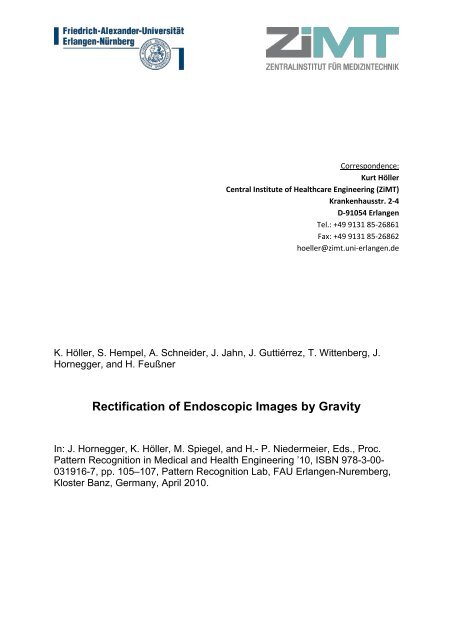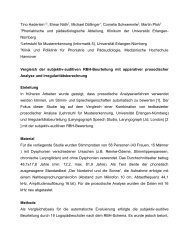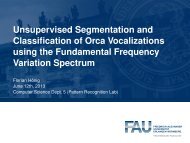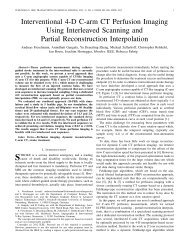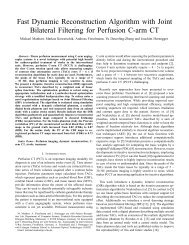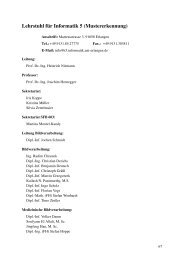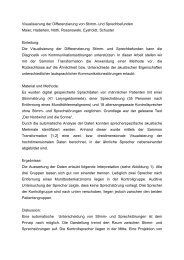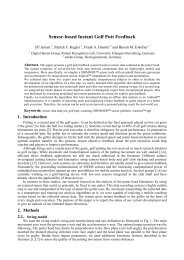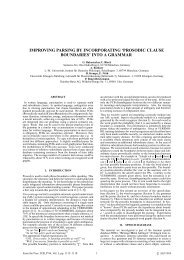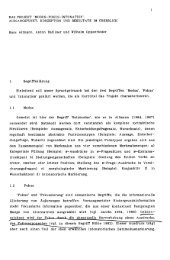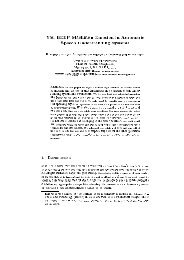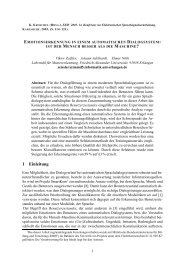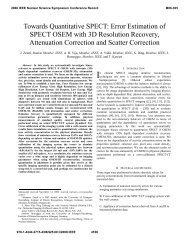Rectification of Endoscopic Images by Gravity
Rectification of Endoscopic Images by Gravity
Rectification of Endoscopic Images by Gravity
Create successful ePaper yourself
Turn your PDF publications into a flip-book with our unique Google optimized e-Paper software.
Correspondence:Kurt HöllerCentral Institute <strong>of</strong> Healthcare Engineering (ZiMT)Krankenhausstr. 2-4D-91054 ErlangenTel.: +49 9131 85-26861Fax: +49 9131 85-26862hoeller@zimt.uni-erlangen.deK. Höller, S. Hempel, A. Schneider, J. Jahn, J. Guttiérrez, T. Wittenberg, J.Hornegger, and H. Feußner<strong>Rectification</strong> <strong>of</strong> <strong>Endoscopic</strong> <strong>Images</strong> <strong>by</strong> <strong>Gravity</strong>In: J. Hornegger, K. Höller, M. Spiegel, and H.- P. Niedermeier, Eds., Proc.Pattern Recognition in Medical and Health Engineering ’10, ISBN 978-3-00-031916-7, pp. 105–107, Pattern Recognition Lab, FAU Erlangen-Nuremberg,Kloster Banz, Germany, April 2010.
<strong>Rectification</strong> <strong>of</strong> <strong>Endoscopic</strong> <strong>Images</strong> <strong>by</strong> <strong>Gravity</strong>K. Höller 1,2,3 , S. Hempel 2,3 , A. Schneider 3 , J. Jahn 4 , J. Guttierrez 4 , T. Wittenberg 4 ,H. Feußner 3 , and J. Hornegger 1,21 Central Institute <strong>of</strong> Healthcare Engineering (ZIMT),Friedrich-Alexander-University Erlangen-Nuremberg, Erlangen, Germany2 Pattern Recognition Lab, Department <strong>of</strong> Computer Science,Friedrich-Alexander-University Erlangen-Nuremberg, Martensstr. 3, 91058 Erlangen,Germany3 Workgroup for Minimal Invasive Surgery MITI, Klinikum r.d. Isar, TechnicalUniversity Munich, Germany4 Fraunh<strong>of</strong>er Institute for Integrated Circuits (IIS), Erlangen, GermanyAbstract. Image rotation correction even in non-rigid endoscopic surgery(particularly NOTES) can be realized with a tiny MEMS tri-axial inertialsensor placed on the tip <strong>of</strong> an endoscope <strong>by</strong> measuring the impact<strong>of</strong> gravity on each <strong>of</strong> the three orthogonal axes. After an initial calibrationthe rotation angle can be estimated with some calculations out<strong>of</strong> these three values. Achievable repetition rate is above the usual endoscopicvideo frame rate <strong>of</strong> 30Hz, accuracy is about one degree. Theimage rotation was performed <strong>by</strong> rotating just digitally a capture <strong>of</strong>the endoscopic analogue video signal which can be realized in real-time.Improvements and benefits have been evaluated in animal studies: Coordination<strong>of</strong> different instruments and estimation <strong>of</strong> tissue behaviourregarding gravity related deformation and movement was considered tobe much more intuitive having a stable horizon on endoscopic images.1 MethodOne <strong>of</strong> the biggest problems with flexible endoscopy in Natural Orifice Translumenal<strong>Endoscopic</strong> Surgery (NOTES) [1] is the missing information about image orientation[2]. Thus, tip retro-flexion <strong>of</strong> a non-rigid endoscope causes image rotation angles till±180 degrees.Our approach to measure this orientation angle is to integrate a Micro Electro-MechanicalSystem (MEMS) based inertial sensor device in the endoscope’s tip, which measuresinfluencing forces in three orthogonal directions [3,4]. If the endoscope is not moving,only the acceleration <strong>of</strong> gravity has an effect on the three axes. Using an arc tangentfunction the rotation angle Φ can be computed out <strong>of</strong> acceleration values F y and F zon the two axes y and z orthogonal to the endoscopic line <strong>of</strong> view in x-direction:Φ = arctan2(F y, F z) (1)First, a preceded 3×3 calibration matrix, which incorporates misalignment and scalingerrors [5], has to be retrieved <strong>by</strong> initial measurements. Moreover a peak eliminationis the result <strong>of</strong> clever down sampling the measuring frequency, which is considerablyhigher than the image frame rate, using a weighted sum algorithm. To avoid bouncingor jittering images as a result <strong>of</strong> the angle correction, additional filtering is necessary.
106Fig. 1. EndoSens Hardware with ENDOrientation Algorithm for <strong>Endoscopic</strong> Image<strong>Rectification</strong>Hence, prior to angle calculation, the measures <strong>of</strong> each axis are filtered with a Hannfilter to smooth angle changes and with a minimum variation threshold to suppressdithering.With the employed sensor there is a uniform quantization <strong>of</strong> 8 bit for a range <strong>of</strong> ±2.3gfor each axis. This implies a quantization accuracy <strong>of</strong> 0.018g per step or 110 steps forthe focused range <strong>of</strong> ±g. This is high enough to achieve a durable accuracy even to adegree within relatively calm movements. This is possible as roll angle Φ is calculatedout <strong>of</strong> inverse trigonometric values <strong>of</strong> two orthogonal axes. Single extraordinary disturbedMEMS values or superposed accelerations with the same order <strong>of</strong> magnitude asgravity are suppressed <strong>by</strong> the ENDOrientation algorithm [6].2 ResultsDuring a porcine animal study, the navigation complexity <strong>of</strong> a hybrid endoscopic instrumentduring a NOTES peritoneoscopy with the well established trans-sigmoidalaccess [7] was compared with and without automated image rotation. To evaluate thebenefit <strong>of</strong> automated real-time MEMS based image rectification, four different needlemarkers were inserted through the abdominal wall to the upper right, lower right, lowerleft and upper left quadrants. These four needle markers had to be grasped with atrans-abdominal introduced endoscopic needle holder under standardized conditions.The minimum time, the mean time and the maximum time have been lower with imagerectification for every position [8]. All participating surgeons considered the complexitylower using our ENDOrientation technique.
107References1. Rattner, D., Kalloo, A.: ASGE/SAGES working group on Natural Orifice Translumenal<strong>Endoscopic</strong> Surgery: White Paper October 2005. Surg Endosc vol 20 (2006)329-333.2. Höller, K., Petrunina, M., Penne, J., Schneider, A., Wilhelm, D., Feussner, H.,Hornegger, J.: Taking endoscopy to a higher dimension: Computer Aided 3-DNOTES. In: Proc. 4th Russian-Bavarian Con-ference on Bio-Medical Engineering,Zelenograd, Moscow, MIET (July 2008) 33-37.3. Höller, K., Penne, J., Schneider, A. et al.: <strong>Endoscopic</strong> orientation correction. In:Medical Image Computing and Computer Assisted Intervention, 12th InternationalConference Proceedings MICCAI’09 London, UK (September 2009) 459-466.4. Höller, K., Schneider, A., Jahn, J. et al.: Orientation <strong>of</strong> <strong>Endoscopic</strong> <strong>Images</strong>: <strong>Rectification</strong><strong>by</strong> <strong>Gravity</strong>. In: J Biomed Eng, August 2010, in Press.5. Höller, K.: Characterization and modeling <strong>of</strong> an inertial sensor for navigation <strong>of</strong>autonomous systems. Friedrich-Alexander-Universitt Erlangen-Nrnberg (October2005).6. Höller, K., Penne, J., Schneider, A. et al.: Suppression <strong>of</strong> shock based errors withgravity related endoscopic image rectifcation. In: Proc. 5th Russian-Bavarian Conferenceon Bio-Medical Engineering Munich, Germany (July 2009) 43-47.7. Wilhelm, D., Meining, A., von Delius, S., et al.: An innovative, safe and sterilesigmoid access (ISSA) for NOTES. Endoscopy vol 39 (2007) 401-406.8. Höller, K., Schneider, A., Jahn, J. et al.: Clinical evaluation <strong>of</strong> ENDOrientation:<strong>Gravity</strong> related rectifcation for endoscopic images. In: Proceedings <strong>of</strong> the ISPA,Salzburg, Austria (September 2009) 713-717.


